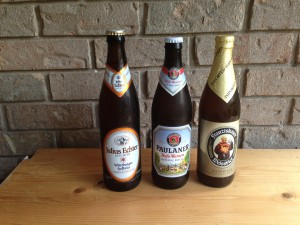This is the start of our third series on beer styles. At Beer and Wine Journal, we hope to eventually cover all the major beer styles, focusing on what sets them apart from other styles and how to brew them successfully at home. The first two styles we covered were dry stouts and hoppy pale ales (encompassing American-style pale ales, IPAs and dIPAs).

Three German hefe-weizens on the shelf at my local liquor store today. This style is easy to brew for beginners, but also has plenty of opportunities for advanced brewers to tweak and experiment.
German hefe-weizens (roughly, yeasty wheat beers) are wonderful beers. At home, you can brew one using almost the same procedures you would employ to make a pale ale, or any other ale, and get good results. For example, if you took the correct ingredients and performed a single infusion mash, boiled the wort as you normally would, pitched an adequate amount of yeast and held the fermentation in normal ale temperature range, you’d likely end up with a tasty hefeweizen.
However, dig a little bit deeper into brewing the style and you’ll find that you have many opportunities to tweak the character of the beer. Switching to a step mash and adding a certain mash rest, your yeast strain, your pitching rate, your fermentation temperature and other variables can all be manipulated to alter the character of your hefe-weizen to your liking. In this series on hefe-weizens, I’ll explain the key points to making a hefe-weizen and, most importantly, the variables that make the biggest influence on how the beer turns out. In this wheat ale, the process has as much to do with your final results as your ingredients. I’ll also dispel a few common myths about making hefe-weizens along the way.
Hefe-weizen
Hefe-weizens are generally pale, cloudy, moderate-strength ales, topped with a healthy head of foam. Their aroma is spicy and phenolic, mixed with a banana-like estery note. They have a little “zing” from the wheat and some “bite” from the high carbonation levels, but they are not tart or sour. Hefe-weizens are not hoppy, but they aren’t particularly sweet either. The bready flavor from the malts, combined with the “spice” from the yeast, is what you notice most when drinking one. Many German hefe-weizens are exported to the United States, with Paulaner, Ayinger, Weinstephaner, Julius Echter, Franziskaner and others being common.
There are many variants of wheat beers. In Germany, these include kristall-weizens (clear wheat beers), dunkelweizens (dark wheat beers), weizenbocks (strong wheat beers) and Berliner weisses (sour wheat beers). In Belgium, there are also witbiers (white beers) and lambics (soured wheat beers). Around the globe there are farmhouse ales, saisons, American wheat beers and others. For this series, I’ll stick to the traditional German hefe-weizen version of a wheat beer.
Water
In some ways, brewing a hefe-weizen is similar to brewing any pale-colored ale. And your brewing water is one example of this. If you are an extract brewer, follow the general guidelines for water treatment. Your best bet is to use soft, distilled or RO water for dissolving your malt extract. The extract will contain all the appropriate minerals that you will need. However, even hard tap water will work. As long as you treat any tap water either by carbon filtration or by adding a Campden tablet (one tablet per 20 gallons/76 L), you will be fine.
For an all-grain brewer, your goal is simply to get the mash to fall in the right pH range (5.2–5.6). You can do this either by adding the appropriate minerals to your water (perhaps after some dilution with distilled water, if needed), directly acidifying the mash or by using the appropriate amount (up to ~5%) of acidulated malt in your grist. If you really want to go nuts, you could even try an acid rest. In Germany, hefe-weizens are brewed from waters ranging from fairly soft to quite hard, so simply do whatever it takes to get your water to work. I’ve never heard of any brewer fiddling with the chloride to sulfate ratio in their hefe-weizen, but if you’re going to, I’d recommend shooting for a ratio around 1:1.

Hi Chris
Just want to say how great these articles are. I’m attempting to perfect my hefeweizen recipe and this is a phenomenal write up. Thank you!
Glad you liked it. Thanks!